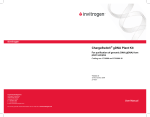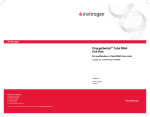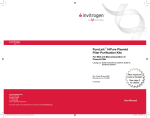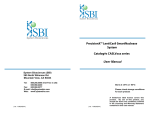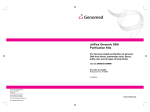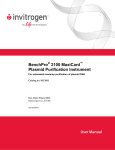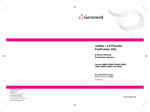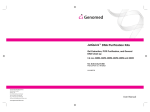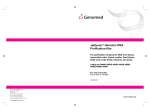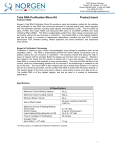Download ChargeSwitch® gDNA Tissue Kits
Transcript
ChargeSwitch® gDNA Tissue Kits For purification of genomic DNA from tissue samples Catalog nos. CS11203 and CS11204 Rev. date: 20 May 2010 Manual part no. 25-0817 MAN0000505 Corporate Headquarters 5791 Van Allen Way Carlsbad, CA 92008 T: 1 760 603 7200 F: 1 760 602 6500 E: [email protected] For country-specific contact information visit our web site at www.invitrogen.com User Manual ii Table of Contents Kit Contents and Storage .................................................................................... iv Introduction ........................................................................................ 1 Product Overview ..................................................................................................1 Experimental Outline ............................................................................................3 Methods............................................................................................... 4 General Information ..............................................................................................4 Isolating Genomic DNA Using the Micro Tissue Kit.......................................7 Isolating Genomic DNA Using the Mini Tissue Kit.......................................13 Troubleshooting ...................................................................................................18 Appendix ........................................................................................... 21 Accessory Products..............................................................................................21 Technical Support ................................................................................................22 Purchaser Notification.........................................................................................24 iii Kit Contents and Storage Types of Kits This manual is supplied with the following products. Product Catalog no. ® Shipping and Storage ChargeSwitch gDNA Micro Tissue Kit CS11203 ChargeSwitch® gDNA Mini Tissue Kit CS11204 All components of the ChargeSwitch® gDNA Tissue Kits are shipped at room temperature. Upon receipt, store the Proteinase K and RNase A at 4C. Store all other components at room temperature. All components are guaranteed stable for 6 months if stored properly. Kit Contents The components supplied in the ChargeSwitch® gDNA Tissue Kits are listed below. The reagents supplied are sufficient to perform 25 (Mini Tissue) or 50 (Micro Tissue) purifications. Note: Some reagents in the kit may be provided in excess of the amount needed. Component Micro Tissue 55 mL -- ChargeSwitch Lysis Buffer (L15) -- 50 mL ChargeSwitch ® Magnetic Beads 3 × 1 mL 2 × 1 mL Proteinase K (20 mg/mL in 50 mM Tris-HCl, pH 8.5, 5 mM CaCl2, 50% glycerol) 500 μL 500 μL RNase A (5 mg/mL in 10 mM TrisHCl, pH 8.5, 10 mM EDTA) 250 μL 250 μL ChargeSwitch® Purification Buffer (N5) 10 mL 10 mL ® ChargeSwitch Lysis Buffer (L13) ® ® ChargeSwitch Wash Buffer (W12) 50 mL 100 mL ChargeSwitch® Elution Buffer (E5; 10 mM Tris-HCl, pH 8.5) 10 mL 10 mL Intended Use iv Amount Mini Tissue For research use only. Not intended for any animal or human therapeutic or diagnostic use. Introduction Product Overview Description of the System The ChargeSwitch® gDNA Mini and Micro Tissue Kits allow rapid and efficient purification of genomic DNA from mini (10–25 mg) or micro (3–5 mg) quantities of tissue, respectively. After preparing the lysates, you may purify DNA in less than 15 minutes using the ChargeSwitch® Technology. For more information about the ChargeSwitch® Technology, see page 2. Intended Use for the Kits The ChargeSwitch® gDNA Tissue Kits are designed to allow isolation of genomic DNA from the following sources. The purified genomic DNA is suitable for use in downstream applications including PCR, restriction enzyme digestion, and Southern blotting. Advantages Micro-Tissue Kit: Purifies up to 5 μg of genomic DNA from 1–2 mm diameter mouse ear clips or 3–5 mg of tissue. This sample size is suitable for genomic DNA purification from micro-dissected or laser capture microdissected samples. Mini-Tissue Kit: Purifies up to 30 μg of genomic DNA from 0.5 cm mouse tail tips or approximately 25 mg of tissue. For spleen tissue, reduce tissue size to 10 mg. Use of the ChargeSwitch® gDNA Tissue Kits to isolate genomic DNA provides the following advantages: Uses a magnetic bead-based technology to isolate genomic DNA without the need for hazardous chemicals, centrifugation, or vacuum manifolds Rapid and efficient purification of genomic DNA from micro or mini quantities of tissue in less than 15 minutes following sample preparation and lysis Simple lysis of tissues with Proteinase K without the need for any mechanical lysis Minimal contamination with RNA The purified genomic DNA demonstrates improved downstream performance in applications including PCR, restriction enzyme digestion, and Southern blotting. Continued on next page 1 Product Overview, Continued System Specifications Mini-Tissue Micro-Tissue Starting Material: 10–25 mg 3–5 mg Elution Volume: 250 μL 150 μL DNA Yield: Up to 30 μg Up to 5 μg DNA Size: > 20 kb > 20 kb The ChargeSwitch® Technology (CST®) is a novel magnetic The ® ChargeSwitch bead-based technology that provides a switchable surface charge dependent on the pH of the surrounding buffer to Technology facilitate nucleic acid purification. In low pH conditions, the CST® beads have a positive charge that binds the negatively charged nucleic acid backbone (see figure below). Proteins and other contaminants are not bound and are simply washed away in an aqueous wash buffer. To elute nucleic acids, the charge on the surface of the bead is neutralized by raising the pH to 8.5 using a low salt elution buffer (see figure below). Purified DNA elutes instantly into this elution buffer, and is ready for use in downstream applications. Low pH ChargeSwitch® Bead Binding Capacity: Magnetic Bead Bead Size: Specifications 2 High pH 5–10 μg genomic DNA per mg < 1 μm Bead Concentration: 25 mg/mL Storage Buffer: 10 mM MES, pH 5.0, 10 mM NaCl, 0.1% Tween 20 Experimental Outline Introduction The figure below illustrates the basic steps necessary to purify genomic DNA from tissues using the ChargeSwitch® gDNA Tissue Kits. Lyse sample Bead charge Bind DNA to ChargeSwitch® magnetic beads Wash beads containing DNA to remove contaminants Elute DNA from beads Charge on pH < 6.0 Charge on pH = 7.0 Charge off pH = 8.5 3 Methods General Information User Supplied Materials MagnaRack™ A magnetic separation rack suitable for use with 1.5 mL microcentrifuge tubes (see below) Sterile, 1.5 mL microcentrifuge tubes Vortex mixer 20 μL, 200 μL, and 1 mL sterile, pipette tips Water bath at 55C The MagnaRack™ available from Invitrogen (see page 21) is a two-piece magnetic separation rack for use in protocols with magnetic beads. The MagnaRack™ consists of a magnetic base station and a removable tube rack. The tube rack can hold up to 24 microcentrifuge tubes. The tube rack fits onto the magnetic base station in two different positions, associating the row of 12 neodymium magnets with a single row of 12 tubes for simple ‘on the magnet’ and ‘off the magnet’ sample processing (see figure below). For more information, see www.invitrogen.com or call Technical Support (page 22). Continued on next page 4 General Information, Continued Safety Information Follow the safety guidelines below when using the ChargeSwitch® gDNA Tissue Kit. Treat all reagents supplied in the kit as potential irritants. Always wear a suitable lab coat, disposable gloves, and protective goggles. If a spill of the buffers occurs, clean with a suitable laboratory detergent and water. If the liquid spill contains potentially infectious agents, clean the affected area first with laboratory detergent and water, then with 1% (v/v) sodium hypochlorite or a suitable laboratory disinfectant. Follow the guidelines below when handling the Handling the ChargeSwitch® ChargeSwitch® magnetic beads. Magnetic Do not freeze the beads as this irreparably damages Beads them. Store the beads at room temperature. Always keep the beads in solution. Do not allow them to dry out as this renders them non-functional. When using the beads, resuspend thoroughly in the storage buffer by vortexing before removal. Discard beads after use. Do not reuse. Continued on next page 5 General Information, Continued Elution Buffer ChargeSwitch® Elution Buffer (E5; 10 mM Tris-HCl, pH 8.5) is supplied with the kit for eluting the DNA from the ChargeSwitch® Magnetic Beads. For best results, use Elution Buffer (E5) to elute the DNA. Alternatively, TE Buffer, pH 8.5–9.0 is acceptable. Note that the pH must be 8.5–9.0, otherwise the DNA will not elute. Do not use water for elution. The protocol recommends eluting the genomic DNA in 150 μL (Micro Kit) or 250 μL (Mini Kit) of ChargeSwitch® Elution Buffer (E5). You may vary the amount of ChargeSwitch® Elution Buffer (E5) used to obtain genomic DNA in the desired final concentration. For best results, always use a volume of ChargeSwitch® Elution Buffer (E5) that is equal to or greater than the volume of ChargeSwitch® Magnetic Beads used in the protocol. If the volume of ChargeSwitch® Elution Buffer (E5) is lower than the volume of beads used, DNA elution is incomplete. You may need to perform a second elution to recover all DNA. 6 Isolating Genomic DNA Using the Micro Tissue Kit Introduction Starting Material This section provides guidelines and instructions to isolate genomic DNA from micro quantities of tissue using the ChargeSwitch® gDNA Micro Tissue Kit (Catalog no. CS11203). Use this procedure to isolate genomic DNA from: 1–2 mm mouse ear clips 3–5 mg tissue If you wish to isolate genomic DNA from larger amounts of tissue or from mouse tail tips, see Isolating Genomic DNA Using the Mini Tissue Kit, page 13. Materials Needed Tissue sample(s) (see above) MagnaRack™ (see page 21) or other magnetic separation rack Sterile 1.5 mL microcentrifuge tubes Vortex mixer Sterile pipette tips (20 μL, 200 μL, and 1 mL) Water bath Components Supplied with the Kit ChargeSwitch® Lysis Buffer (L15) Proteinase K RNase A ChargeSwitch® Magnetic Beads ChargeSwitch® Purification Buffer (N5) ChargeSwitch® Wash Buffer (W12) ChargeSwitch® Elution Buffer (E5) or TE Buffer (not supplied; 10 mM Tris-HCl, 1 mM EDTA, pH 8.5) Continued on next page 7 Isolating Genomic DNA Using the Micro Tissue Kit, Continued Before Starting Perform the following before beginning: Set a water bath at 55C. Prepare Lysis Mix: For each sample, mix 1 mL of ChargeSwitch® Lysis Buffer (L15) and 10 μL of Proteinase K to prepare the Lysis Mix. When isolating DNA from multiple samples, scale up the volume of reagents used and prepare a master Lysis Mix. Note: The ChargeSwitch® Lysis Buffer may appear slightly cloudy. If cloudy, shake the bottle before use until the solution becomes clear. Preparing the Tissue Lysate Follow the procedure below to prepare a lysate from the tissue sample. 1. Place the tissue sample into a sterile microcentrifuge tube. 2. Add 1 mL of Lysis Mix (see above) to the tube. Ensure that the tissue is completely immersed in the Lysis Buffer. 3. Vortex for 10–15 seconds to mix. 4. Incubate the sample overnight at 55C until lysis is complete. Note: The length of the incubation step can be shortened to 1-2 hours by vortexing the sample at least 4 times during this period. 5. Add 5 μL of RNase A to the lysate. Pipet up and down gently 5 times or until a homogeneous solution is obtained. Important: Use a 1 mL pipette tip set to 900 μL to mix the sample. Make sure that the tip is submerged, and pipet up and down gently to avoid forming bubbles as this may result in shearing of the DNA. 6. Incubate at room temperature for 5 minutes. 7. Proceed to Binding DNA, next page. Continued on next page 8 Isolating Genomic DNA Using the Micro Tissue Kit, Continued Binding DNA Follow the procedure below to bind the DNA to the ChargeSwitch® Magnetic Beads. 1. Vortex the tube containing the ChargeSwitch® Magnetic Beads to fully resuspend and evenly distribute the beads in the storage buffer. Make sure that all of the solution containing the beads is at the bottom of the tube. 2. Add 200 μL of ChargeSwitch® Purification Buffer (N5) to the digested tissue sample (from Step 6, previous page) and pipet up and down gently twice to mix. Note: Adding the ChargeSwitch® Purification Buffer lowers the pH of the sample, and optimizes the binding conditions. 3. Add 40 μL of ChargeSwitch® Magnetic Beads (from Step 1) to the sample and pipet up and down gently 5 times to mix. 4. Incubate at room temperature for 1 minute to allow the DNA to bind to the ChargeSwitch® Magnetic Beads. 5. Place the sample in the MagnaRack™ for 1 minute or until the beads have formed a tight pellet. 6. Without removing the tube from the MagnaRack™, carefully remove the supernatant and discard. Take care not to disturb the pellet of beads by angling the pipette such that the tip is pointed away from the pellet (see figure below). Pipette tip Magnetic pellet 7. Proceed immediately to Washing DNA, next page. Continued on next page 9 Isolating Genomic DNA Using the Micro Tissue Kit, Continued Washing DNA 1. Remove the tube containing the pelleted magnetic beads from the MagnaRack™ (Step 6, previous page). There should be no supernatant in the tube. 2. Add 1 mL of ChargeSwitch® Wash Buffer (W12) to the tube and pipet up and down gently twice to resuspend the magnetic beads. Important: Use a 1 mL pipette tip set to 900 μL to mix the sample. Make sure that the tip is submerged, and pipet up and down gently to avoid forming bubbles. 3. Place the sample in the MagnaRack™ for 1 minute or until the beads have formed a tight pellet. 4. Without removing the tube from the MagnaRack™, carefully remove the supernatant and discard. Take care not to disturb the pellet of beads by angling the pipette such that the tip is pointed away from the pellet (see figure on page 9). 5. Repeat Steps 1–4. 6. Proceed to Eluting DNA, next page. Continued on next page 10 Isolating Genomic DNA Using the Micro Tissue Kit, Continued Eluting DNA 1. Remove the tube containing the pelleted magnetic beads from the MagnaRack™ (Step 5, previous page). There should be no supernatant in the tube. 2. Add 150 μL of ChargeSwitch® Elution Buffer (E5) (or TE Buffer, pH 8.5) to the tube and pipet up and down gently 10 times to resuspend the magnetic beads. Important: Do not use water for elution. The DNA will not elute due to the poor buffering capacity of water. 3. Incubate at room temperature for 5 minutes. Tip: For maximum yield, mix the suspension of beads (by pipetting up and down gently) half way through the incubation. Incubating the sample at 55C may also improve yield. 4. Place the sample in the MagnaRack™ for 1 minute or until the beads have formed a tight pellet. 5. Without removing the tube from the MagnaRack™, carefully remove the supernatant containing the DNA to a sterile microcentrifuge tube. Take care not to disturb the pellet of beads by angling the pipette such that the tip is pointed away from the pellet (see figure on page 9). Note: If the eluate containing the DNA is discolored, repeat Steps 5–6. Storing DNA 6. Discard the used magnetic beads. Do not reuse the beads. Store the purified DNA at –20C or use immediately for the desired downstream application. Avoid repeatedly freezing and thawing DNA. Store the purified DNA at 4C for short-term use or aliquot the DNA and store at –20C for long-term storage. Continued on next page 11 Isolating Genomic DNA Using the Micro Tissue Kit, Continued Quantitating DNA Yield You may estimate the yield of purified genomic DNA by checking the UV absorbance at 260 nm or using one of the Quant-iT™ DNA Assay Kits. UV Absorbance 1. Measure the A260 of the solution using a spectrophotometer blanked against 10 mM Tris-HCl, pH 8.5. 2. Calculate the amount of DNA using the formula: DNA (μg) = A260 50 μg/(A260 × 1 mL) × dilution factor × total sample volume (mL) For DNA, A260 = 1 for a 50 μg/mL solution measured in a cuvette with an optical path length of 1 cm. Quant-iT™ DNA Assay Kits The Quant-iT™ DNA Assay Kits (see page 21 for ordering information) provide a rapid, sensitive, and accurate method for dsDNA quantitation with minimal interference from RNA, protein, ssDNA (primers), or other common contaminants that affect UV absorbance. Each kit contains a state-of-the-art quantitation reagent, pre-diluted standards for a standard curve, and a pre-made buffer to allow fluorescence-based DNA quantitation. For more information, see www.invitrogen.com or call Technical Support (page 22). 12 Isolating Genomic DNA Using the Mini Tissue Kit Introduction This section provides guidelines and instructions to isolate genomic DNA from mini quantities of tissue using the ChargeSwitch® gDNA Mini Tissue Kit (Catalog no. CS11204). Starting Material Use this procedure to isolate genomic DNA from: 0.5 cm mouse tail tips Up to 25 mg tissue (up to 10 mg only for spleen tissue) If you wish to isolate genomic DNA from smaller amounts of tissue or from mouse ear clips, see Isolating Genomic DNA Using the Micro Tissue Kit, page 7. Materials Needed Tissue sample(s) (see above) 1 mL mini glass homogenizer (if isolating DNA from tissues other than mouse tail tips; Fisher, Cat no. NC9051099) MagnaRack™ (see page 21) or other magnetic separation rack Sterile 1.5 mL microcentrifuge tubes Vortex mixer Sterile pipette tips (20 μL, 200 μL, and 1 mL) Water bath Components Supplied with the Kit ChargeSwitch® Lysis Buffer (L13) Proteinase K RNase A ChargeSwitch® Magnetic Beads ChargeSwitch® Purification Buffer (N5) ChargeSwitch® Wash Buffer (W12) ChargeSwitch® Elution Buffer (E5) or TE Buffer (not supplied; 10 mM Tris-HCl, 1 mM EDTA, pH 8.5) Continued on next page 13 Isolating Genomic DNA Using the Mini Tissue Kit, Continued Preparing the Tissue Lysate Follow the procedure below to prepare a cell lysate from the tissue sample. 1. Set a water bath at 55C. 2. Prepare the tissue samples as follows: For mouse tail tips: Place the tissue sample into a sterile 1.5 mL microcentrifuge tube. Add 1 mL of ChargeSwitch® Lysis Buffer (L13) to the tube. Ensure that the tissue is completely immersed in the Lysis Buffer. For other tissues: Place the tissue in a 1 mL mini glass homogenizer. Add 1 mL of ChargeSwitch® Lysis Buffer (L13) to the tube. Homogenize with approximately 8 strokes until the tissue is welldispersed. Transfer the homogenized tissue to a sterile 1.5 mL microcentrifuge tube. 3. Add 20 μL of Proteinase K to the tube. 4. Vortex or invert the tube for 10–15 seconds to mix. 5. Incubate the sample for 1.5–3 hours at 55C until lysis is complete. The lysate should appear clear. Note: Some tissues (e.g. brain) can produce a cloudy lysate at 55C. This does not adversely affect purification. 6. For samples containing bone or hair: Centrifuge the sample for 1 minute at 13,000 rpm. Transfer the supernatant to a clean tube. For all other samples: Proceed directly to Step 7. 7. Add 10 μL of RNase A to the lysate. Invert the tube to mix the solution. 8. Incubate at room temperature for 2 minutes. 9. Proceed to Binding DNA, next page. Continued on next page 14 Isolating Genomic DNA Using the Mini Tissue Kit, Continued Binding DNA Follow the procedure below to bind the DNA to the ChargeSwitch® Magnetic Beads. 1. Vortex the tube containing the ChargeSwitch® Magnetic Beads to fully resuspend and evenly distribute the beads in the storage buffer. Make sure that all of the solution containing beads is at the bottom of the tube. 2. Add 120 μL of ChargeSwitch® Magnetic Beads (from Step 1) to the digested tissue sample (from Step 8, page 14) and pipet up and down gently 5 times to mix. Important: Use a 1 mL pipette tip set to 900 μL to mix the sample. Make sure that the tip is submerged, and pipet up and down gently to avoid forming bubbles as this may result in shearing of the DNA. 3. Add 100 μL of ChargeSwitch® Purification Buffer (N5) to the sample and pipet up and down gently (with a 1 mL pipette tip) 10 times to mix. Note: Adding the ChargeSwitch® Purification Buffer lowers the pH of the sample, and allows DNA to bind to the beads. 4. Place the sample in the MagnaRack™ for 2 minutes or until the beads have formed a tight pellet. Note: Some tissues (e.g. spleen) may produce a viscous supernatant that retards the movement of the beads, prolonging separation times. If this occurs, leave the sample in the MagnaRack™ until the beads have formed a tight pellet and the supernatant is clear. 5. Without removing the tube from the MagnaRack™, carefully remove the supernatant and discard. Take care not to disturb the pellet of beads by angling the pipette such that the tip is pointed away from the pellet (see figure below). Pipette tip Magnetic pellet 6. Proceed immediately to Washing DNA, next page. Continued on next page 15 Isolating Genomic DNA Using the Mini Tissue Kit, Continued Washing DNA 1. Remove the tube containing the pelleted magnetic beads from the MagnaRack™ (Step 5, previous page). There should be no supernatant in the tube. 2. Add 1 mL of ChargeSwitch® Wash Buffer (W12) to the tube and pipet up and down gently twice to resuspend the magnetic beads. Important: Use a 1 mL pipette tip set to 900 μL to mix the sample. Make sure that the tip is submerged, and pipet up and down gently to avoid forming bubbles. 3. Place the sample in the MagnaRack™ for 1 minute or until the beads have formed a tight pellet. 4. Without removing the tube from the MagnaRack™, carefully remove the supernatant and discard. Take care not to disturb the pellet of beads by angling the pipette such that the tip is pointed away from the pellet (see figure on page 15). 5. Repeat Steps 1–4. 6. Proceed to Eluting DNA, next page. Continued on next page 16 Isolating Genomic DNA Using the Mini Tissue Kit, Continued Eluting DNA 1. Remove the tube containing the pelleted magnetic beads from the MagnaRack™ (Step 5, previous page). There should be no supernatant in the tube. 2. Add 250 μL of ChargeSwitch® Elution Buffer (E5) (or TE Buffer, pH 8.5) to the tube and pipet up and down gently twice to resuspend the magnetic beads. Important: Do not use water for elution. The DNA will not elute due to the poor buffering capacity of water. 3. Incubate at 55C for 5 minutes. 4. Place the sample in the MagnaRack™ for 2 minutes or until the beads have formed a tight pellet. 5. Without removing the tube from the MagnaRack™, carefully remove the supernatant containing the DNA to a sterile microcentrifuge tube. Take care not to disturb the pellet of beads by angling the pipette such that the tip is pointed away from the pellet (see figure on page 15). Note: If the eluate containing the DNA is discolored, repeat Steps 4–5. Storing DNA Quantitating DNA Yield 6. Discard the used magnetic beads. Do not reuse the beads. Store the purified DNA at –20C or use immediately for the desired downstream application. Avoid repeatedly freezing and thawing DNA. Store the purified DNA at 4C for short-term use or aliquot the DNA and store at –20C for long-term storage. To quantitate yield of your DNA, use UV absorbance or one of the Quant-iT™ DNA Assay Kits. For more information, see page 12. 17 Troubleshooting Introduction Problem Low DNA yield Refer to the table below to troubleshoot problems that you may encounter when purifying genomic DNA with the kit. Cause Incomplete lysis Solution Decrease the amount of starting material used. Be sure to add Proteinase K during lysis. Make sure that the tissue is completely immersed in the Lysis Buffer. Increase the length of incubation at 55C. For mini quantities of tissue, homogenize tissue before lysis. Poor quality of starting material Be sure to use fresh sample and process immediately after collection or freeze the sample at –80C or in liquid nitrogen. The yield and quality of DNA isolated depends on the type and age of the starting material. Insufficient amount of Vortex the tube containing the ChargeSwitch® ChargeSwitch® Magnetic Beads Magnetic Beads added to fully resuspend the beads in solution before adding them to your sample. Pellet of beads disturbed or lost during binding or washing steps Keep the sample in the MagnaRack™ when removing supernatant during the binding or washing steps. Remove the supernatant without disturbing the pellet of beads by angling the pipette tip away from the pellet. Continued on next page 18 Troubleshooting, Continued Problem Low DNA yield, continued Cause Incorrect elution conditions Solution After adding ChargeSwitch® Elution Buffer (E5) to the sample, pipet up and down to resuspend the magnetic beads before incubation. Incubate the sample at 55C to improve the yield. Do not use water to elute DNA. Use Elution Buffer (E5) or TE, pH 8.5. No DNA recovered Incomplete dissociation of DNA from the ChargeSwitch® Magnetic Beads Perform additional mixing of the suspension of beads (by pipetting up and down). Water used for elution Do not use water for elution. The elution buffer must have a pH = 8.5–9.0 or the DNA will remain bound to the ChargeSwitch® Magnetic Beads. Use ChargeSwitch® Elution Buffer (E5) or TE, pH 8.5. ChargeSwitch® Magnetic Beads stored or handled improperly Store beads at room temperature. Do not freeze the beads as they will become irreparably damaged. Elute DNA at 65C. Make sure that the beads are in solution at all times and do not become dried. Beads that have dried out are nonfunctional. Eluate containing DNA is discolored Magnetic pellet disturbed during elution Repeat the elution step (Eluting DNA, Steps 4–5, page 11 or page 17). Continued on next page 19 Troubleshooting, Continued Problem Cause Solution RNA contamination Forgot to add RNase A Perform RNase A digestion prior to binding the DNA to the magnetic beads. DNA is sheared or degraded Lysate mixed too vigorously or small pipette tips used during mixing Use a 1 mL pipette tip set to 900 μL to mix the sample. Bubbles formed during mixing steps Make sure that the pipette tip is submerged in the solution during mixing. DNA repeatedly frozen and thawed Aliquot DNA and store at 4C or –20C. Avoid repeated freezing and thawing. DNA contaminated with DNases Maintain a sterile environment while working (i.e. wear gloves and use DNase-free reagents). 20 Pipet up and down gently to mix. Appendix Accessory Products The table below lists additional products available from Invitrogen that may be used with the ChargeSwitch® gDNA Tissue Kits. In addition, the table lists a selection of ChargeSwitch® gDNA Kits that are available for purification of genomic DNA from other sources. For more information about these and other ChargeSwitch® gDNA Kits, visit www.invitrogen.com or contact Technical Support (page 22). Additional Products Product MagnaRack™ Amount Catalog no. 1 rack CS15000 ® 50 purifications CS11000 ® 50 purifications CS11040 ® ChargeSwitch gDNA 50 μL Sheep Blood Kit 50 purifications CS11300 ChargeSwitch® gDNA Mini Bacteria Kit 50 purifications CS11301 ChargeSwitch gDNA Normalized Buccal Cell Kit 50 purifications CS11020 ChargeSwitch® gDNA Buccal Cell Kit 50 purifications CS11021 ChargeSwitch Forensic DNA Purification Kit 100 purifications CS11200 Quant-iT™ DNA Assay Kit, High Sensitivity 1000 assays Q33120 Quant-iT™ DNA Assay Kit, Broad-Range 1000 assays Q33130 ChargeSwitch gDNA 100 μL Blood Kit ChargeSwitch gDNA 1 mL Serum Kit ® ® E-Gel® Agarose Gels and DNA Ladders E-Gel® Agarose Gels are bufferless, pre-cast agarose gels designed for fast, convenient electrophoresis of DNA samples. E-Gel® agarose gels are available in different agarose percentages and well formats. In addition, a large variety of DNA ladders is available from Invitrogen for sizing DNA. For more information about these products, see www.invitrogen.com or contact Technical Support (page 22). 21 Technical Support World Wide Web Contact Us Visit the Invitrogen website at www.invitrogen.com for: Technical resources, including manuals, vector maps and sequences, application notes, SDSs, FAQs, formulations, citations, handbooks, etc. Complete technical support contact information Access to the Invitrogen Online Catalog Additional product information and special offers For more information or technical assistance, call, write, fax, or email. Additional international offices are listed on our Web page (www.invitrogen.com). Corporate Headquarters: European Headquarters: 5791 Van Allen Way Carlsbad, CA 92008 USA Tel: 1 760 603 7200 Tel (Toll Free): 1 800 955 6288 Fax: 1 760 602 6500 E-mail: [email protected] Inchinnan Business Park 3 Fountain Drive Paisley PA4 9RF, UK Tel: +44 (0) 141 814 6100 Tech Fax: +44 (0) 141 814 6117 E-mail: [email protected] Continued on next page 22 Technical Support, Continued SDS Requests SDSs (Safety Data Sheets) are available on our website at www.invitrogen.com/sds. Limited Warranty Invitrogen is committed to providing our customers with high-quality goods and services. Our goal is to ensure that every customer is 100% satisfied with our products and our service. If you should have any questions or concerns about an Invitrogen product or service, contact our Technical Support Representatives. Invitrogen warrants that all of its products will perform according to specifications stated on the certificate of analysis. The company will replace, free of charge, any product that does not meet those specifications. This warranty limits Invitrogen Corporation’s liability only to the cost of the product. No warranty is granted for products beyond their listed expiration date. No warranty is applicable unless all product components are stored in accordance with instructions. Invitrogen reserves the right to select the method(s) used to analyze a product unless Invitrogen agrees to a specified method in writing prior to acceptance of the order. Invitrogen makes every effort to ensure the accuracy of its publications, but realizes that the occasional typographical or other error is inevitable. Therefore Invitrogen makes no warranty of any kind regarding the contents of any publications or documentation. If you discover an error in any of our publications, please report it to our Technical Support Representatives. Invitrogen assumes no responsibility or liability for any special, incidental, indirect or consequential loss or damage whatsoever. The above limited warranty is sole and exclusive. No other warranty is made, whether expressed or implied, including any warranty of merchantability or fitness for a particular purpose. 23 Purchaser Notification Limited Use Label License No. 5: Invitrogen Technology The purchase of this product conveys to the buyer the nontransferable right to use the purchased amount of the product and components of the product in research conducted by the buyer (whether the buyer is an academic or for-profit entity). The buyer cannot sell or otherwise transfer (a) this product (b) its components or (c) materials made using this product or its components to a third party or otherwise use this product or its components or materials made using this product or its components for Commercial Purposes. The buyer may transfer information or materials made through the use of this product to a scientific collaborator, provided that such transfer is not for any Commercial Purpose, and that such collaborator agrees in writing (a) not to transfer such materials to any third party, and (b) to use such transferred materials and/or information solely for research and not for Commercial Purposes. Commercial Purposes means any activity by a party for consideration and may include, but is not limited to: (1) use of the product or its components in manufacturing; (2) use of the product or its components to provide a service, information, or data; (3) use of the product or its components for therapeutic, diagnostic or prophylactic purposes; or (4) resale of the product or its components, whether or not such product or its components are resold for use in research. For products that are subject to multiple limited use label licenses, the terms of the most restrictive limited use label license shall control. Life Technologies Corporation will not assert a claim against the buyer of infringement of patents owned or controlled by Life Technologies Corporation which cover this product based upon the manufacture, use or sale of a therapeutic, clinical diagnostic, vaccine or prophylactic product developed in research by the buyer in which this product or its components was employed, provided that neither this product nor any of its components was used in the manufacture of such product. If the purchaser is not willing to accept the limitations of this limited use statement, Life Technologies is willing to accept return of the product with a full refund. For information about purchasing a license to use this product or the technology embedded in it for any use other than for research use please contact Out Licensing, Life Technologies, 5791 Van Allen Way, Carlsbad, California 92008 ; Phone (760) 603-7200 or email: [email protected] ©2010 Life Technologies Corporation. All rights reserved. 24 Notes 25 Notes 26 Corporate Headquarters 5791 Van Allen Way Carlsbad, CA 92008 T: 1 760 603 7200 F: 1 760 602 6500 E: [email protected] For country-specific contact information visit our web site at www.invitrogen.com User Manual
































